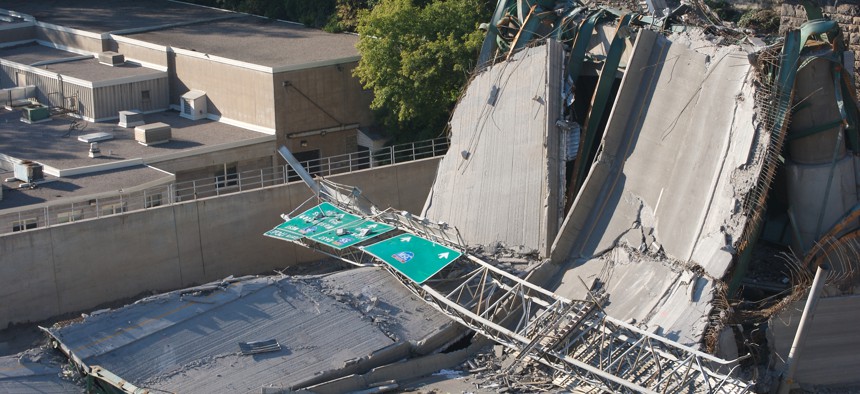
I-35W bridge collapse in Minneapolis Pete Markham (Creative Commons)
America’s Bridges Are at Risk and Here’s Why
Technological and process failures have resulted in preventable tragedy and pose a threat to bridge safety nationwide.
It’s now been over seven years since Minneapolis’s I-35W Mississippi River bridge suddenly collapsed in August 2007, killing 13 people and injuring another 145 in the midst of rush hour traffic. Yet, despite the tragedy’s widespread publicity and media coverage, it’s unclear whether meaningful changes have been made since then to bridge inspections processes.
According to the Government Accountability Office, 1 in 4 of America’s 607,380 bridges are classified as ‘deficient,’ a category that includes bridges in poor condition, requiring significant maintenance or replacement, inadequate in traffic capacity, or, most disturbingly, with significant risk for structural failure. The latter category, defined as “fracture critical,” includes bridges like the I-35W bridge that rely on support structures (i.e., steel beams or trusses) that if experienced some sort of damage could cause the bridge to collapse due to lack of structural redundancy. In the case of the I-35W bridge, parts of its support structure had started corroding and ultimately gave way, which investigators now suspect was caused by chemicals sprayed on the bridge to prevent black ice over multiple Minnesotan winters.
Though the overall number of deficient bridges has slowly fallen since 2002, more than 18,000 of America’s bridges are fracture critical and require regular inspections. Unfortunately, there are still significant challenges to monitoring these structures.
Bridge inspections still largely rely on decades-old technology and processes. After a bridge collapse killed 46 people in 1967, Congress established the National Bridge Inspection Program, which gives all bridges a sufficiency rating score from 0 to 100 based on a variety of structural, serviceability, and design factors. The accuracy and reliability of these scores, created from reports filed by Federal Highway Administration (FHWA)-trained inspectors, has received scrutiny in recent years.
For instance, take the I-5 Skagit River Bridge in Washington state, which collapsed in May 2013, leaving a husband and wife stranded for 90 minutes on the roof of their partially-submerged car. While the bridge had recently been given a sufficiency score of 57/100 and was cited for functional issues like lane width and vertical clearance, it had failed to be identified as being at risk for any structural issues that could result in potential collapse. It wasn’t until after the accident -- which was caused by an oversize truck striking several support beams -- that the bridge was identified as having a fracture critical design.
Bridge evaluation scores like these have long been criticized due to a reliance on in-person, visual inspections that may or may not paint a full picture of structural soundness. A 2001 FHWA report, The Reliability of Visual Inspection for Highway Bridges, concluded that its own visual inspections were largely unreliable. Lack of appropriate or comprehensive technological capabilities is also an issue: the National Transportation Safety Board’s investigation into the I-35W accident noted that parts of the bridge that were fracture critical and ultimately gave way to the collapse due to “inadequate use” of available inspection technologies.
Luckily, new tools on the horizon may help improve the quality of inspections and monitoring of bridges. University engineering researchers in Missouri and Massachusetts have begun experimenting with how drones might be used to conduct aerial inspections much more efficiently and accurately. Others are employing wireless machine-to-machine (M2M) technology, a system of connected sensors that can continuously monitor the status of bridges and other key infrastructure. And since the accident, NTSB officials have launched training efforts to increase the utilization of existing technologies like x-rays, thermographs, and radar, which together can provide inspectors a fuller picture of a bridge’s structural health.
However, even if these technologies are adopted, agencies must overcome current confusion regarding accountability and inspection authority. All highway bridges that receive federal funds require mandatory inspections every two years, but FHWA has struggled to ensure compliance from uncooperative state governments and to fully resolve the lack of clarity about the level of oversight and authority wielded by different regional and municipal safety organizations. As federal, state, and local agencies work in tandem to address these issues in bridge safety, they will need to take into account these technological, process, and bureaucratic challenges.
This post is written by Government Business Council; it is not written by and does not necessarily reflect the views of Government Executive Media Group's editorial staff. For more information, see our advertising guidelines.